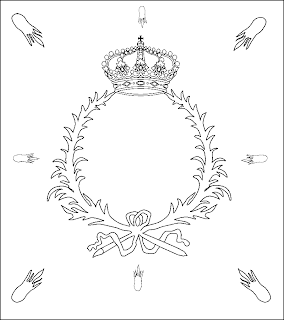Having posted flag templates without the full details i.e. minus the ciphers and emblems, I wonder if I ought to post ones that are the complete Prussian flags, along with colouring details. Someone might find them useful? Well, we'll see what response I get! ;-) Comments, please.

Being a uniform and flag design service to wargamers and to the imaginary crowned heads of 17th and 18th Century Europe, especially of the Seven Years War period - now By Appointment to the Court of Saxe-Bearstein! (But please note that the uniforms and flags presented here are not fictional - they are genuine 17th and 18th Century uniforms and flags that are as authentic as I can make them from my sources.)
Flag List Pages
▼
Saturday, 23 February 2008
Prussian Regular Infantry Style Flag (Regiment 9, 11 and many others)
Friday, 22 February 2008
Prussian Garrison Infantry Style Flag of Regiments 1 and 2
Thursday, 21 February 2008
Prussian Style Cuirassier Standard Template
Flags and heraldry: clipart and free software
A few people have mentioned that they'd like flag templates and I have considered doing some. The only problem is time! Any time I spend doing flags will be time I don't have for doing uniform templates. I don't really have any easy way of finding out if there is sufficient demand to justify diversifying production at the Tippelbruder shop...
Anyway, one suggestion I have for those who would like to do their own flags fairly easily is to download Inkscape from http://www.inkscape.org, learn the basics of this interesting and free vector graphics program and then acquire some of the wide range of free .svg heraldry clipart from e.g. http://commons.wikimedia.org/wiki/Category:SVG_coat_of_arms_elements (explore the links on this site for a very wide variety of clipart). It is far easier to manipulate and re-use elements in vector drawings than bitmap ones, and the quality of the image does not diminish when it is magnified (unlike the pixellation that happens when enlarging bitmaps). The final product can be exported as e.g. a png file for easy colouring in Paint or some more advanced painting program at as high a resolution as you desire.
Anyway, one suggestion I have for those who would like to do their own flags fairly easily is to download Inkscape from http://www.inkscape.org, learn the basics of this interesting and free vector graphics program and then acquire some of the wide range of free .svg heraldry clipart from e.g. http://commons.wikimedia.org/wiki/Category:SVG_coat_of_arms_elements (explore the links on this site for a very wide variety of clipart). It is far easier to manipulate and re-use elements in vector drawings than bitmap ones, and the quality of the image does not diminish when it is magnified (unlike the pixellation that happens when enlarging bitmaps). The final product can be exported as e.g. a png file for easy colouring in Paint or some more advanced painting program at as high a resolution as you desire.
Wednesday, 20 February 2008
Trooper, 2nd Dragoons (Royal North British Dragoons)

Trooper of the British 2nd Dragoons, the Royal North British Dragoons. Unofficially called The Greys because of their grey horses, a name later officially adopted.
Unit and uniform details to follow.
This is a larger than usual image because at the smaller size the detail of the mitre cap is completely lost. Even at this size the detail is rather crude compared with the original vector image.
Sunday, 17 February 2008
Trooper, 15th Light Dragoons

Trooper of the British 15th Light Dragoons.
Raised 1759 as Eliott's Light Horse (or Dragoons), the regiment went to Germany in 1760 and almost immediately made a name for itself at Emsdorf, where it was claimed to have captured 16 colours, six cannon and 2600 Frenchmen. However, the battle was very costly to the regiment and it had to be withdrawn to reform and recoup its losses in Hannover. The resultant fame and publicity led to the raising of several more regiments of light dragoons and, unlike the light troops attached to the heavy dragoon units, most of them were not disbanded in 1763.
Uniform: Black enamelled cap, white metal crest and mountings (copper or brass metal sometimes depicted as an alternative), white GR cipher and crown on front, the crown showing red enamel through the gaps, turban dark green, horsehair mane red (although possibly originally designated as white over red), two white tassels at back of helmet. Black stock. Red coat with dark green collar, lapels and cuffs, lined white i.e. white turnbacks. White lace loops and white metal buttons on collar, lapels and sleeves. White tufted epaulette on each shoulder. Waistcoat and breeches white. Boots (of a lighter type than used by the heavy cavalry) black. Dark green saddlecloth with a tan leather seat joining the front and rear parts. Edging lace white with red central stripe. Full colour crown with white GR cipher at front. Rear corner red circle surrounded by wreath of natural coloured roses and thistles with LD in white. White fur cover on holsters.








